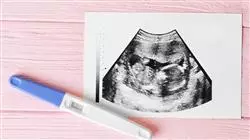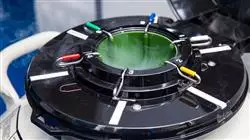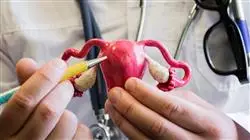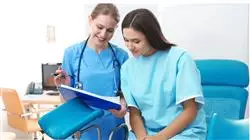University certificate
The world's largest faculty of nursing”
Description
A postgraduate diploma created to offer you the most up-to-date information on Pharmacology and Legal and Psychological Aspects in Assisted Reproduction Services for Nurses"

The main objective of this postgraduate diploma is to familiarize the nursing staff of Assisted Reproduction Units with the different pharmacological treatments involved in the different treatments. The different types of drugs currently on the market and the various hormone treatments will be presented.
Secondly, this program will allow you to learn about the psychosocial, behavioral, cognitive and emotional aspects that patients with fertility problems may present. It will also provide the student with specific communication skills so that they are able to identify any psychological and/or emotional needs of patients who come to the reproduction unit, and can implement interventions to provide holistic and comprehensive care.
The final part of the postgraduate diploma will qualify students in the important legal field of assisted reproduction, which will provide students with the ability to resolve multiple legal issues, both in matters related to the legality, uses and limits of assisted reproduction techniques, as well as any doubts about the use and approach of informed consents.
With this postgraduate diploma you will be able to combine high intensity learning with your professional and personal life, achieving your goals in a simple and real way"
This postgraduate diploma in Pharmacology and the Legal and Psychological Aspects in Nursing in the Assisted Reproduction Service offers the characteristics of a high level scientific, teaching and technological course. These are some of its most notable features:
- The latest technology in online teaching software
- A highly visual teaching system, supported by graphic and schematic contents that are easy to assimilate and understand
- Practical cases presented by practising experts
- State-of-the-art interactive video systems
- Teaching supported by telepractice
- Continuous updating and recycling systems
- Autonomous learning: full compatibility with other occupations
- Practical exercises for self-evaluation and learning verification
- Support groups and educational synergies: questions to the expert, debate and knowledge forums
- Communication with the teacher and individual reflection work
- Content that is accessible from any fixed or portable device with an Internet connection
- Supplementary documentation databases are permanently available, even after the course
Acquire the specific competencies of nursing in the field of Assisted Reproduction consultation and perform with the solvency of a high-level professional"
Our teaching staff is made up of professionals from different fields related to this specialty. In this way, TECH makes sure to offer the training update objective it intends. A multidisciplinary team of professionals trained and experienced in different environments, who will develop the theoretical knowledge in an efficient way, but above all, they will bring their practical knowledge from their own experience to the program: one of the differential qualities of this training.
This mastery of the subject matter is complemented by the effectiveness of the methodological design of this postgraduate diploma in Pharmacology and the Legal and Psychological Aspects in Nursing in the Assisted Reproduction Service. Developed by a multidisciplinary team of postgraduate diploma, it integrates the latest advances in educational technology. In this way, the student will be able to study with a range of comfortable and versatile multimedia tools that will give him the operability he needs in his training.
The design of this program is based on Problem-Based Learning: an approach that conceives learning as a highly practical process. To achieve this remotely, TECH will use telepractice: with the help of an innovative interactive video system and Learning from an Expert, the student will be able to acquire the knowledge as if they were facing the scenario they are learning at that moment. A concept that allows students to integrate and memorize what they have learnt in a more realistic and permanent way.
A training created and directed by professional experts in Assisted Reproduction that turn this postgraduate diploma into a unique opportunity for professional growth"

The learning of this postgraduate diploma is supported by the best didactic means and the best online resources to guarantee that your efforts will have the best possible results"
Objectives
The objective of this training is to provide nursing professionals with the necessary knowledge and skills to perform their activity in the area of Assisted Reproduction. Through a work approach that is totally adaptable to the student, this postgraduate diploma will progressively lead him or her to acquire the skills that will propel him or her to a much higher professional level.

Become one of the most sought-after professionals of the moment, with this postgraduate diploma in Pharmacology and the Legal and Psychological Aspects in Nursing in the Assisted Reproduction Service"
General Objectives
- Broaden specific knowledge of each of the areas of work in assisted reproduction
- Enable students to be interdependent and problem solvers
- Facilitate good performance of nursing professionals in order to provide the best care throughout the process
Specific Objectives
Module 1. Pharmacology
- Develop which are the main folliculogenesis inducers, what are the advantages and disadvantages of each of them and which are the most widely used at present
- Acquire knowledge about the types of gonadotropins that exist and how treatment results
- Develop knowledge on the management of ovulation inducers
- Acquire a broad knowledge of the hormonal treatments that exist, which are the most commonly used and which are the most effective
- Conduct good health education to teach self-administration of drugs at home
- Know and develop the consequences of ovarian stimulation, and explain what ovarian hyperstimulation syndrome is
- Study the handling and routes of administration of drugs used in Assisted Reproduction
- Promote the participation of nursing personnel during Assisted Reproduction treatments
- Explain what clomiphene citrate is, in what situations it is used and how it is administered
- Develop what is an aromatase inhibitor and discern its advantages and disadvantages
- Study when gonadotropin analogues are used and in which cases they are used
- Pain management and control after puncture
Module 2. Psychological Support and Special Situations in Assisted Reproduction
- Understand the psychological, social, cognitive and behavioral aspects of infertility
- Detect psychological or emotional alterations derived from infertility diagnoses and/or derived from reproduction treatment
- Provide emotional support to the patient throughout the process of Assisted Reproduction
- Develop communication skills to enable a comprehensive approach to infertility counseling and treatment
- Take into consideration special health situations of the beneficiaries of reproductive treatments, which entails the acquisition of different knowledge and therapeutic skills by nursing professionals
- Bereavement Management and Support
- Nutritional advice and follow-up in Assisted Reproduction consultation
Module 3. Legal and Ethical Aspects in Assisted Reproduction
- Know the current legislation on Assisted Reproduction in Spain, being our main objective to know how to transfer all this knowledge to practice and be able to solve legal issues in clinical practice
- Detail in the portfolio of common services provided by the national health system on Assisted Reproduction issues
- Know how to interpret and use correctly each of the consents used in Assisted Reproduction: Who will deliver them? How should they be explained? What should they contain? Using many practical examples to do so
- Explain the rights of users undergoing Assisted Reproduction techniques, including gamete donors
- Study the ethical principles in order to apply them later to multiple situations that may arise in the field of Assisted Reproduction
- Address and discuss from an ethical and scientific point of view current issues such as surrogacy, post-mortem maternity, advanced maternal age and the influence that religious or cultural beliefs may have on users of Assisted Reproduction techniques
- Generate a debate on access to Assisted Reproduction treatments in private centers: Commercialization of a right?

A boost to your CV that will give you the competitiveness of the best prepared professionals in the labor market"
Postgraduate Diploma in Pharmacology and Legal and Psychological Aspects in Nursing in Assisted Reproduction Services.
Pharmacology is one of the fields in which the permanent scientific and technological advances in medicine are most evident. In order for health professionals, specifically Nursing personnel, to be able to offer an effective and quality service in the area of assisted reproduction, it is necessary to update their knowledge. For this reason, at TECH Technological University we developed this Postgraduate Diploma course in which students can become familiar with the different pharmacological treatments used in this procedure and the legal and psychological implications of this practice on the patient.
Become an expert and perform with skill.
The main objective of this Postgraduate Diploma course in Pharmacology and Legal and Psychological Aspects in the Assisted Reproduction Service is to favor Specialization in Nursing professionals. In this sense, the curriculum focuses on expanding specific knowledge in each of the areas of work of assisted reproduction. In this way, our students will learn about the management of the main drugs used in these treatments, from the application of various inducers to ovarian stimulation; their management, route of administration and the advantages or possible disadvantages of each one of them. They will also learn about the current legislation of this clinical practice and the psychological, social, cognitive and behavioral aspects of infertility and participation in artificial fertilization treatments for the patient.
Study at the largest Nursing School in the world.
At TECH we offer you an updated scientific program, with innovative methodologies for online study, support from experts in the field and theoretical and practical classes that involve the study of real cases. Through the most complete content of the educational market, you will study the pharmacology and the legal and psychological aspects in the artificial fertilization service. Considering the importance of specialized education for professionals, we strive to promote accessible and high capacity Postgraduate Certificates, in order to respond to the particular needs of each student.







